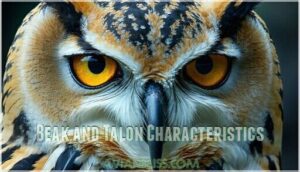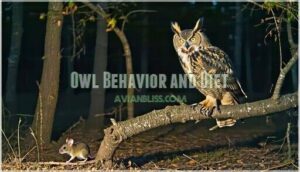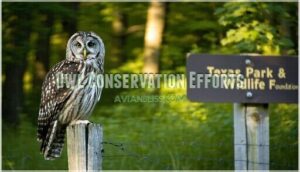This site is supported by our readers. We may earn a commission, at no cost to you, if you purchase through links.

These nocturnal hunters call everything home—dense East Texas forests, sprawling Hill Country ranches, and even your neighborhood park.
The ghostly Barn Owl glides silently over farmland while Screech-Owls nest in suburban oak trees.
Each species has carved out its perfect niche, whether it’s the Burrowing Owl making underground homes on the plains or Barred Owls preferring cypress swamps.
Texas’s diverse habitats create a raptor paradise that’ll surprise you with hidden hunting strategies and survival tricks.
Table Of Contents
- Key Takeaways
- Texas Owl Species
- Owl Physical Characteristics
- Texas Owl Habitats
- Owl Behavior and Diet
- Owl Conservation Efforts
- Frequently Asked Questions (FAQs)
- What owls are common in Texas?
- Is it good to have an owl in your yard?
- Which owl makes a hoo hoo sound?
- Can an owl pick up a 20 lb dog?
- What type of owl lives in Texas?
- What do owls in Texas eat?
- Why attract owls to your yard?
- How do weather patterns affect Texas owl migration?
- What factors threaten owl populations in Texas?
- How does urbanization impact Texas owls?
- Conclusion
Key Takeaways
- You’ll find 14 distinct owl species throughout Texas, ranging from the massive Great Horned Owl with its 4-foot wingspan to the tiny Elf Owl that’s smaller than your smartphone, each adapted to different habitats across the state.
- Texas owls thrive in every environment you can imagine—from dense East Texas forests where Barred Owls call to urban neighborhoods where Eastern Screech-Owls nest in backyard trees, proving their remarkable adaptability.
- You’ll benefit from having owls in your area since they’re natural pest controllers, with species like Barn Owls consuming thousands of rodents annually while providing free, eco-friendly pest management for farms and residential areas.
- Conservation challenges threaten Texas owl populations through habitat loss, pesticide use, and urban development, but you can help by supporting habitat preservation, reducing chemical use, and participating in citizen science monitoring programs.
Texas Owl Species
You’ll discover 14 distinct owl species across Texas, ranging from the powerful Great Horned Owl with its distinctive ear tufts to the heart-faced Barn Owl that hunts silently through grasslands.
These nocturnal raptors occupy every habitat from dense eastern forests where Barred Owls call to open prairies where Short-eared Owls patrol during winter months.
Great Horned Owl
You’ll recognize the great horned owl by its distinctive ear tufts and impressive two-foot height.
These magnificent raptors stand tall as Texas’s most recognizable nocturnal predator, ruling every habitat from city parks to remote wilderness.
This texas owls powerhouse dominates every habitat from forests to cities, making it the most common owl species texas offers.
Their hunting strategies include silent swoops from perches, targeting everything from rodents to skunks.
Listen for their deep "hoo-hoo-hoo" vocalizations echoing through Texas nights.
These owls also use vocal mimicry, and can imitate other species.
Barred Owl
You’ll spot Barred Owls throughout eastern Texas’s mature forests, where their distinctive "who-cooks-for-you" calls echo through wooded areas.
These stocky, round-headed owls lack ear tufts and display brown-streaked plumage perfect for camouflage.
They’re expanding westward, creating habitat competition with other species.
Their opportunistic diet includes small mammals, birds, and amphibians, making them adaptable predators in diverse owl habitats across the region, with a distinctive call that echoes through their territory.
Eastern Screech-Owl
You’ll find Eastern Screech Owls throughout Texas in two distinct color phases.
These compact owls adapt remarkably well to urban environments, making their tremolo calls from backyard trees.
Key Eastern Screech Owl Features:
- Red Morph vs Gray Morph – Same species, different coloration for camouflage
- Nesting Habits – Prefer tree cavities and nest boxes in residential areas
- Vocalizations – Distinctive whinnying trill, not actually a screech sound
- Urban Adaptation – Thrive near human settlements, parks, and wooded neighborhoods
Barn Owl
Barn Owl’s distinctive heart-shaped face and silent flight make it unmistakable among Texas owls.
You’ll spot this pale hunter gliding over grasslands at night, providing excellent rodent control for farmers.
Their global distribution includes year-round Texas residence, with nesting habits favoring abandoned barns and old buildings.
Watch for their ghostly white appearance during evening hunts across open habitats, utilizing their silent flight.
Rare Owl Species
Beyond common barn owls, Texas hosts several vagrant owl species that challenge even experienced birders.
These endangered owls face serious conservation challenges, with habitat specificity limiting their range and population estimates remaining critically low.
The diverse habitats of Texas support a variety of owl species, including the ubiquitous Great Horned Owl.
Rare Texas Owl Species:
- Snowy Owl – Arctic visitors during owl irruption years, spotted occasionally in northern counties with distinctive white plumage
- Ferruginous Pygmy Owl – North America’s rarest owl species, confined to extreme southern Texas brush country
- Stygian Owl – Dark-eyed vagrant from Mexico, documented fewer than five times statewide
Owl Physical Characteristics
You’ll notice that Texas owls display remarkable physical adaptations, from the Great Horned Owl’s impressive 4-foot wingspan to the tiny Eastern Screech-Owl’s 6-inch frame.
Each species features distinct characteristics like facial discs, ear tufts, and specialized plumage patterns that help you identify them in the field, showcasing their unique physical adaptations.
Size and Plumage
Texas owls showcase remarkable diversity in owl size and coloration.
You’ll notice dramatic size dimorphism between species, from tiny screech owls to massive Great Horned Owls.
Plumage variation creates effective camouflage patterns that help with owl identification across different owl species texas.
| Species | Size Range | Primary Coloration | Camouflage Patterns |
|---|---|---|---|
| Great Horned Owl | 18-25 inches | Mottled brown-gray | Tree bark mimicry |
| Eastern Screech-Owl | 6-10 inches | Red/gray morphs | Bark texture blend |
| Barn Owl | 12-16 inches | Golden-white | Open field adaptation |
| Barred Owl | 16-20 inches | Brown-white bars | Woodland concealment |
Feather morphology varies substantially, with juvenile plumage often differing from adult Texas owls, and showcasing substantial variation in terms of size and coloration, which is a key aspect of owl identification.
Ear Tufts and Facial Features
Beyond their impressive size differences, you’ll notice that Texas owls showcase remarkable facial diversity.
Each species displays unique ear tuft function and facial disc variations that help with hunting precision.
Here are four key owl face shapes and features to recognize:
- Great Horned Owls – Prominent feather tufts resembling horns with asymmetrical ears for precise sound location
- Barn Owls – Heart-shaped facial discs with no ear tufts, creating perfect sound funnels
- Screech Owls – Small, pointed ear tufts with compact facial patterns for camouflage
- Barred Owls – Round faces without tufts, featuring distinct brown and white feather patterns
These owl characteristics serve as your best identification tools when spotting Texas owls in the wild.
Beak and Talon Characteristics
Owl beaks showcase incredible beak curvature with razor-sharp hooks designed for tearing flesh.
You’ll notice their powerful talons demonstrate remarkable talon morphology – four toes with needle-like claws that deliver crushing grip strength.
Their hunting adaptations work together perfectly, with specialized bird foot adaptations allowing owls to snatch prey silently.
Their bird beak adaptations and feather integration create the ultimate predatory package.
Color Patterns and Camouflage
You’ll notice how feather pigmentation creates stunning owl coloration that serves as nature’s perfect disguise.
Disruptive coloration breaks up their body outline, while cryptic owls blend seamlessly into bark and branches.
Bird camouflage techniques include intricate owl markings that mimic tree patterns.
Countershading aids concealment by minimizing shadows.
Bird coloration patterns shift subtly through seasonal plumage changes, though mimicry remains their primary survival strategy year-round.
Texas Owl Habitats
You’ll find Texas owls in surprisingly diverse environments, from dense East Texas forests where Barred Owls call through the canopy to wide-open grasslands where Short-eared Owls hunt during daylight hours.
These adaptable raptors have colonized every habitat type across the state, including urban parks, coastal marshes, desert scrublands, and even your neighborhood barn or abandoned building, showcasing their ability to thrive in various environments.
Forest and Woodland Habitats
Dense canopies and towering trees create perfect sanctuaries for Texas’s forest owls.
You’ll discover Barred Owls and Eastern Screech-Owls thriving in these wooded refuges, where mature trees provide essential nesting sites and abundant prey availability supports healthy populations.
Owls sometimes require supplemental nesting structures if natural cavities are limited.
- Ancient oaks whisper secrets – their hollow trunks shelter generations of owl families
- Moonlight filters through leaves – creating magical hunting grounds for nocturnal predators
- Every branch tells a story – of survival against mounting habitat loss pressures
Grassland and Prairie Habitats
Wide open spaces across Texas support Prairie Owls like Burrowing Owls and Short-eared Owls.
You’ll spot Burrowing Owls near ground burrows in grasslands, while Short-eared Owls hunt over meadows during winter months.
Habitat loss threatens these species as development expands, and conservation efforts focus on protecting native prairie ecosystems.
Their owl diet includes small rodents and insects found in these open landscapes.
Urban and Suburban Habitats
Several owl species have adapted remarkably well to city life, transforming Texas’s urban landscapes into unexpected hunting grounds.
Great Horned Owls and Barn Owls thrive in metropolitan areas, adjusting their owl behavior and owl diet to urban conditions.
- Suburban Nesting Sites – Owls choose tall trees, church steeples, and abandoned buildings for raising young
- Urban Owl Diets – City birds feast on rats, pigeons, and urban wildlife populations
- City Light Impact – Artificial lighting disrupts natural hunting patterns but creates new opportunities
- Noise Pollution Effects – Traffic sounds mask owl calls, forcing louder vocalizations for communication
These adaptable raptors demonstrate impressive resilience, making owl-human interaction increasingly common as Texas wildlife adjusts to expanding development while maintaining essential owl habitat within city limits.
Some residents even consider using specialized feeding products to support these urban owls.
Coastal and Desert Habitats
Beyond cities and suburbs, you’ll find owls thriving in Texas’s most challenging environments.
Coastal owls like Barn Owls hunt salt marshes where prey availability fluctuates with tides.
West Texas owls demonstrate remarkable desert adaptations, nesting in rocky crevices while facing habitat loss from development.
Climate impact threatens both regions as temperatures rise, affecting south Texas owls and their traditional hunting grounds.
| Habitat Type | Common Species | Key Challenges |
|---|---|---|
| Coastal Marshes | Barn Owl, Short-eared Owl | Habitat loss, storm surge |
| Desert Scrubland | Great Horned Owl, Burrowing Owl | Water scarcity, extreme heat |
| Riparian Zones | Eastern Screech-Owl, Barred Owl | Drought, human encroachment |
The combination of habitat loss and climate change poses significant threats to owl populations across different regions in Texas.
Owl Behavior and Diet
You’ll discover that Texas owls use surprisingly different hunting strategies, from the Great Horned Owl’s patient perch-and-pounce technique to the Burrowing Owl’s unusual ground-level pursuit of prey during daylight hours.
Understanding these behavioral patterns and dietary preferences will help you predict where and when you’re most likely to spot these nocturnal predators in action.
Hunting Techniques and Strategies
Texas owls employ remarkable hunting behavior that makes them apex predators.
You’ll observe these specialized bird hunting strategies across different species, each adapted for maximum efficiency in bird predator-prey relationships.
Here are five key owl hunting techniques:
- Silent Flight – Specialized feathers muffle wing beats completely
- Prey Detection – Asymmetrical ears pinpoint sounds with laser precision
- Ambush Tactics – Patient perching followed by swift swooping attacks
- Nocturnal Vision – Eyes gather 100x more light than humans
- Talon Use – Razor-sharp claws deliver instant, crushing force to owl prey
Owls’ hunting prowess is substantially enhanced by specialized flight feathers.
Nocturnal and Diurnal Behavior
Most Texas owls are nocturnal hunters, becoming active after sunset when their exceptional night vision and silent flight give them advantages.
You’ll notice Great Horned Owls and Barn Owls following these typical nighttime activity cycles.
However, Burrowing Owls break the pattern as diurnal species, hunting during daylight hours. Their sensory adaptations help them adjust hunting times based on seasonal changes and prey availability.
Dietary Preferences and Prey
Texas owls showcase remarkable hunting adaptations that shape complex owl food webs across the state.
You’ll find their bird prey selection varies dramatically—Great Horned Owls tackle rabbits and skunks, while Screech-Owls prefer insects and small rodents.
Regional variations in prey availability directly influence their bird feeding habits, creating diverse bird predator-prey relationships that demonstrate how owl foraging strategies adapt to local ecosystems and dietary impact needs.
Supplementing their diets with insects is vital, as they provide essential protein for growth for growth and overall health, which is a key aspect of their complex owl food webs and diverse bird predator-prey relationships.
Owl Conservation Efforts
You’ll find that Texas owls face various conservation challenges, from habitat loss affecting species like the Spotted Owl to population monitoring programs that track breeding success across the state’s diverse ecosystems.
The Texas Parks & Wildlife Foundation leads stewardship efforts, rehabilitation programs, and public education campaigns that help protect these nocturnal raptors and their critical nesting sites throughout the region, which is a key part of conservation challenges.
Threatened and Endangered Species
Looking at owls beyond their hunting habits reveals concerning conservation challenges.
You’ll find that habitat loss and climate change threaten several Texas species. The Cactus Ferruginous Pygmy-Owl faces critical conservation status due to agricultural development, while prey scarcity affects multiple populations.
Pesticide impact compounds these problems, creating urgent needs for owl conservation efforts throughout the state’s declining habitats.
Texas is home to a diverse range of owls, with 13 native species regularly found.
Habitat Preservation and Restoration
Everyone can make a difference in protecting owl habitats texas through strategic conservation efforts.
Texas wildlife depends on coordinated Forest Management and Grassland Conservation programs that maintain healthy ecosystems. Urban Planning initiatives now incorporate bird habitat conservation requirements, while Wetland Restoration projects create essential hunting grounds.
Habitat destruction remains a significant threat.
Here’s how you can support owl conservation texas:
- Advocate for Protected Areas – Contact local officials about establishing wildlife corridors
- Support native plant restoration – Volunteer with organizations replanting indigenous species
- Participate in citizen science – Report owl sightings to help researchers track populations
- Reduce pesticide use – Maintain chemical-free zones that protect prey species and bird habitats
Rehabilitation and Research Programs
Owl rescue centers across Texas work around the clock to heal injured birds.
The Blackland Prairie Raptor Center treats over 600 patients annually, while rehab techniques help owls return to the wild.
Research funding supports data collection on nesting habits and dietary patterns, advancing our understanding of these magnificent nocturnal hunters through species monitoring and programs like the Texas Barn Owl Project.
Public Education and Awareness Campaigns
Education initiatives spark community involvement through bird outreach programs that teach owl identification and habitat protection.
You’ll find workshops at nature centers demonstrating responsible owl-watching techniques while reducing threats to nesting sites.
Local schools partner with wildlife organizations for hands-on owl awareness activities.
These bird education campaigns transform curious observers into conservation advocates, creating ripple effects throughout Texas communities.
Frequently Asked Questions (FAQs)
What owls are common in Texas?
Three owl species dominate Texas skies year-round: you’ll spot Great Horned Owls with their distinctive ear tufts.
Barred Owls can be found in wooded areas, and Eastern Screech-Owls hiding in various habitats across the state.
Is it good to have an owl in your yard?
Having an owl in your yard is beneficial.
They’re natural pest controllers, eating rodents, insects, and small mammals that damage gardens.
You’ll enjoy reduced pest problems while supporting local wildlife conservation efforts.
Which owl makes a hoo hoo sound?
Great Horned Owls produce the classic "hoo-hoo-hoo" sound you’re probably thinking of.
You’ll hear their deep, resonant hooting echoing through Texas nights, especially during breeding season when they’re claiming territory and attracting mates.
Can an owl pick up a 20 lb dog?
Most raptors can’t lift more than their body weight.
You’ll find that Great Horned Owls, Texas’s largest species at 3-5 pounds, couldn’t carry a 20-pound dog—they’d struggle with anything over four pounds maximum.
What type of owl lives in Texas?
You’ll find seventeen owl species calling Texas home, from the massive Great Horned Owl to tiny screech owls.
Common residents include Barn Owls with heart-shaped faces and Barred Owls in eastern forests.
What do owls in Texas eat?
Diet varies substantially among Texas’s seventeen owl species.
You’ll find they consume rodents, small mammals, birds, reptiles, amphibians, insects, and even bats.
Larger species like Great Horned Owls tackle rabbits and skunks, which are a significant part of their diet.
Why attract owls to your yard?
You’ll benefit from natural pest control as owls hunt rodents, reducing property damage.
They’re fascinating to observe and create a balanced ecosystem.
Plus, hearing their peaceful nighttime ambiance adds to your outdoor space.
How do weather patterns affect Texas owl migration?
Weather dramatically transforms your owl-watching experience.
Cold fronts trigger massive migrations southward, while warm spells delay departures.
You’ll spot more Short-eared and Long-eared Owls during harsh winters when northern birds seek Texas’s milder temperatures.
What factors threaten owl populations in Texas?
Habitat loss from urban development, agricultural expansion, and deforestation poses major threats.
You’ll also see impacts from pesticide use, vehicle strikes, power line collisions, and climate change affecting prey availability and nesting sites.
How does urbanization impact Texas owls?
You’ll find that urbanization creates a mixed bag for Texas owls.
Cities provide new nesting sites in buildings and steady food sources, but light pollution disrupts hunting patterns and traffic poses deadly risks.
Conclusion
Whether you’re exploring East Texas forests or scanning Hill Country ranches, these incredible owls in Texas await your discovery.
From the Great Horned Owl’s commanding presence to the Elf Owl’s pocket-sized charm, each species offers unique behaviors and adaptations.
You’ll find them in backyards, wetlands, and grasslands across the state.
Start listening for their distinctive calls at dusk, bring binoculars for better viewing, and remember that patience rewards dedicated owl watchers with unforgettable wildlife encounters.













